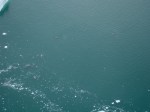Arctic field work connects people of different backgrounds, disciplines, and tribes. Last week I spent 3 days in Maine where I met with Arctic archeologists, anthropologists, and students of all ages. Susan Kaplan and Genevieve LeMoine run the Arctic Peary-McMillan Museum and do extensive field work in Labrador, Cape Sheridan atop Ellesmere Island (Canada), and northern Greenland. A class of smart sophomore asked more questions than I could answer in the morning and a diverse group of citizen did the same in the evening. I represented the “physics tribe.”
We learnt of each other after I posted an illustrated essay “Ruins of Fort Conger” that contained this image taken near Petermann Fjord in 2012

Carl Rose on the left was a seaman on our last 2012 expedition while Jonathan Poole is a marine field technician with whom I work often. They stand before a hut built by Admiral Robert Peary in 1900 on one of his early excursions to reach the North Pole. The 2012 photo bears remarkable similarity to one taken in 1909 that Genevieve LeMoine describes on her blog with title “Tides of the Arctic.”
![Donald MacMillan and Jack Barnes at Fort Conger, spring 1909 [From LeMoine, 2013]](https://icyseas.org/wp-content/uploads/2015/02/3000-32-1808v2b_blog.jpg?w=500&h=317)
Donald MacMillan and Jack Barnes at Fort Conger, spring 1909 [From LeMoine, 2013]
It shows Donald McMillan and Jack Barnes in 1909 during a later Peary expedition. The pictures and histories are displayed at the “Glimmer of the Polar Sea” exhibition at the Bowdoin’s Peary-McMillan Arctic Museum. These huts are the closest “shelter” to Petermann Fjord about 50 miles to the east. The men visiting Fort Conger in 1909 and 2012 look towards the ocean which in 2012 looked like this
We visited the site in 2012 to recover an ocean sensor that, so we hoped, had measured tides and temperatures for 9 years earlier. For 9 long years we had no way to tell, if either sensor or data existed. Only after recovery in 2012 did we jubilantly find sensors and data. At the time we deployed this sensor in 2003 technology did not exist to get data out from the ice-covered ocean. We are trying to develop technology to change this. The non-trivial goal is to get such data out as it is collected without waiting for 9 years. That’s what my crowd-funding project is about: Develop new technologies and share all data, results, and excitement.
If funded, this project will produce results immediately as ocean temperatures (and salinities) will be transmitted to the word wide web for anyone to use as she or he sees fit. Please help and be part of the cutting edge of Arctic Oceanography: Tell your friends, tell your family, and tell your colleagues about the science, about the Arctic, about the beauty, about the climate, and about the physics of the ocean.


![Seaward front of Petermann Glacier Aug.-11, 2012. View is from a small side-glacier towards the south-east across Petermann Fjord with Petermann Gletscher to the left (east). [Photo Credit: Erin Clarke, Canadian Coast Guard Ship Henry Larsen]](https://icyseas.org/wp-content/uploads/2012/11/p1080580.jpg?w=500&h=375)




